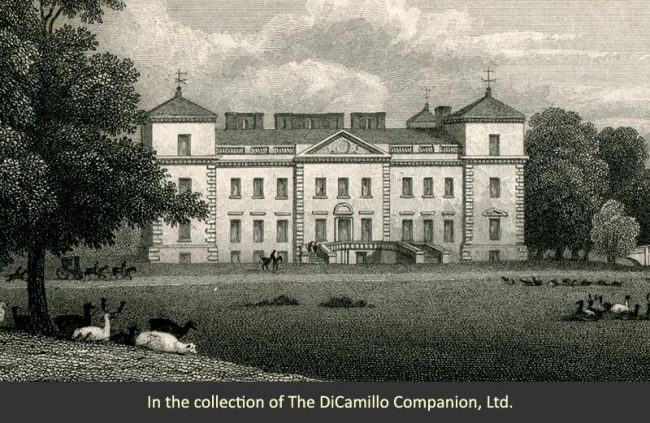
The house from "Neale's Views of Seats," circa 1831.
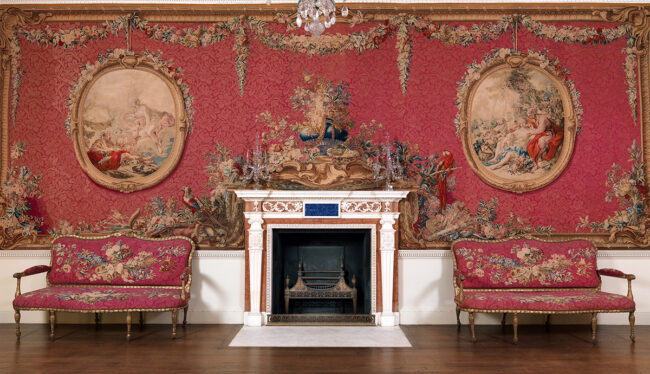
Robert Adam's 1763 Tapestry Room, today in the collection of the Met. This image is in the public domain via the Metropolitan Museum of Art website.
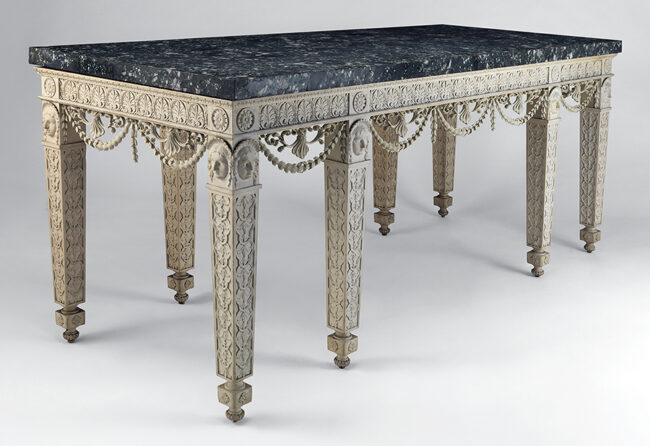
Wood console table designed by Robert Adam for Croome Court and carved by Sefferin Alkenin in 1765, today in the collection of the Met. This image is in the public domain via the Metropolitan Museum of Art website.
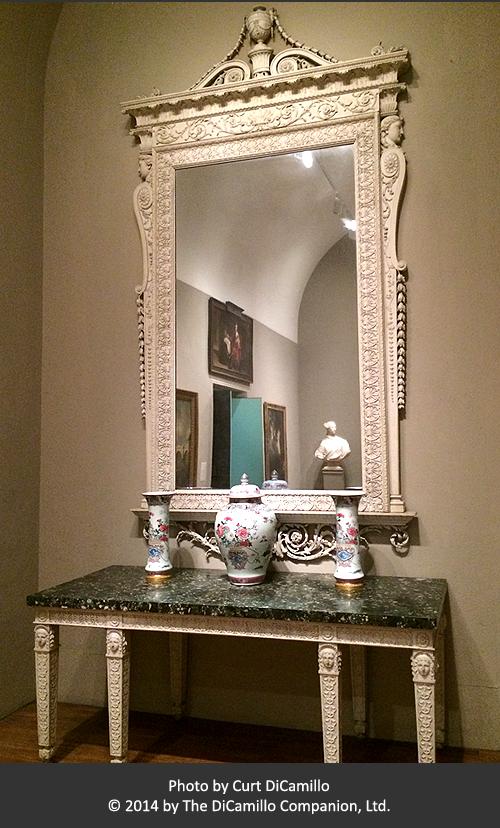
Robert Adam's 1765 painted pine pier glass and table (carved by Sefferin Alken) from Croome, today in the collection of the Philadelphia Museum of Art.
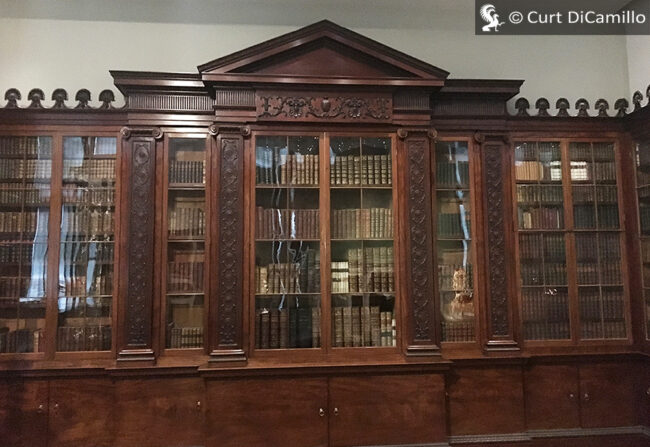
Circa 1763 library bookcase designed by Robert Adam for Croome Court. Today in the collection of the V&A.
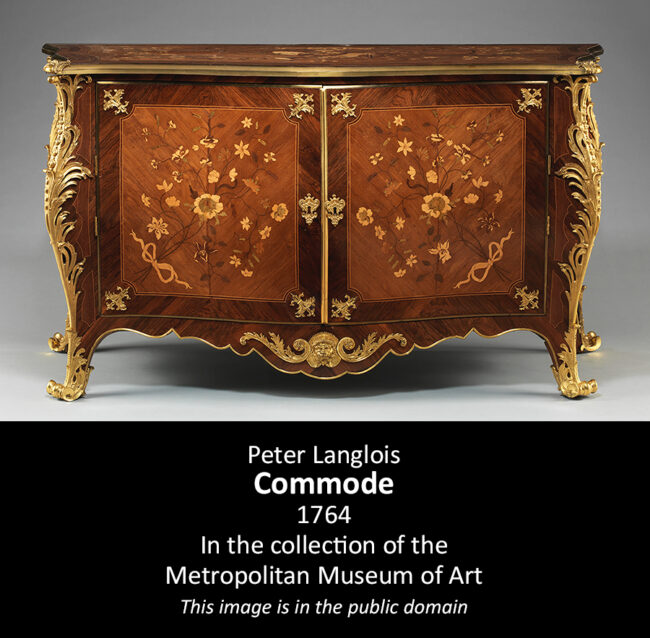
This commode was purchased in 1764 for £55 by the 6th Earl of Coventry for a bedroom at Croome Court
House & Family History: At its core Croome Court incorporates a 1640s house that was almost completely rebuilt in Bath stone in the mid-18th century by Capability Brown, a rare example of the famous landscape designer's architectural work. Croome Court has been visited by George III, Queen Victoria, and George V. At the beginning of World War II the government requisitioned the house; in 1940, after the Nazis occupied the Netherlands, Croome was leased for one year to the Dutch government as a home for Queen Wilhelmina and the Dutch royal family. It appears, however, that the royal family stayed for less than a month, probably because of the noise of RAF Defford, which was near the house, and the fear that proximity to the air base made the house a target for enemy bombing. Croome Court, together with 38 acres, was sold by the Coventry family in 1948 to the Roman Catholic Archdiocese of Birmingham, who ran St. Joseph's Special School in the house from 1950 until 1979. The International Society for Krishna Consciousness (ISKCON) took over Croome Court in 1979 and used it as their UK headquarters and as Chaitanya College, a training center for Maharishi Mahesh Yogi, part of the Hare Krishna movement. They decamped in 1984 and proposals were made to convert the house into flats and offices; this did not come to pass and Croome Court stood empty for over 10 years. In 1999 the house was purchased by Lawrence Bilton, who converted it back into a private family home. With the help of the Heritage Lottery Fund, the house was acquired in 2007 by the Croome Heritage Trust, who spent £4 million on restoration and then leased it to the National Trust for 999 years. The great house opened to the public on September 26, 2009.
Collections: The tapestry room, designed by Robert Adam in 1763 for George Coventry, 6th Earl of Coventry, featured tapestries woven by the Royal Gobelins Manufactory in Paris expressly for the room between 1763 and 1771. Circa 1902 the tapestries and seat furniture (including a set of six Neoclassical armchairs designed in 1769 by Adam) from the tapestry room were sold by the 9th Earl of Coventry to a Parisian dealer. The Samuel H. Kress Foundation acquired the tapestry room's furniture, tapestries, chair rails, doors, chimneypiece, and floors in 1949 and donated them to the Metropolitan Museum of Art in 1958. The Croome Court Room that the Met created features an Axminster carpet that was woven after a 1770s design by Adam for the Library at Harewood House. In addition, the Met also has in its collection a circa 1770-80 Adam-designed candelabrum that was made for Croome. The tapestry room at Weston Park, Shropshire, houses a superb set of Gobelins tapestries on the theme of the love of the gods that were commissioned for Weston by Sir Henry Bridgeman in the 1760s. The set is extremely similar to the Met's Gobelins tapestries from Croome; however, Weston's are in better condition and more brilliant than the Met's. A fine set of bookcases from Croome, made for the 6th Earl of Coventry, circa 1763, are now in the collection of the Victoria & Albert Museum. The 6th Earl also acquired a rare pair of Sèvres potpourris in the form of snail shells in Paris in the 1760s; this pair is one of only five known to exist today and was sold from the Croome Estate in 1991 (the Museum of Fine Arts, Boston, has, in its Forsyth Wickes Collection, one of the existing five sets—in turquoise or bleu céleste—of the Sèvres snail shell potpourris). Historians believe that Robert Adam intended a classical relief to be placed in the plaster frame over the chimneypiece of the dining room in Lansdowne House, London; however, this was never accomplished and the frame remained empty. A Neoclassical grisaille painting from the gallery of Croome Court was found, in 1959, to be almost the perfect size, and placed in the frame, where it remains today (the dining room from Lansdowne House is also at the Metropolitan Museum). The Philadelphia Museum of Art has in its collection a pier glass and table of carved and painted pine that was designed by Adam and made in 1765 (carved by Sefferin Alken) for Croome Court (see photo in "Images" section). Also at the Philadelphia Museum of Art is a Neoclassical pedestal designed by Adam for Croome Court. The Georgian House, Edinburgh, has pelmets on it windows that were removed from Croome Court. The Metropolitan Museum of Art has in its collection a commode made by Peter Langlois in 1764 (see "Images" section) that was originally in a bedroom at Croome.
Comments: Croome Park has been described as one of most influential landscapes in Europe.
Garden & Outbuildings: The landscaping at Croome is considered Capability Brown's first complete landscape design. The grounds are famous for the many follies designed by Robert Adam. During World War II RAF Defford became the main station in Britain for the development of airborne radar. The land for the top secret project was requisitioned by the government from the 10th Earl of Coventry and eventually housed over 2,000 people. There is today a small museum in the house dedicated to the history of RAF Defford and its wartime service. The National Trust acquired 670 acres of the park in 1996 with the help of the Heritage Lottery Fund.
Chapel & Church: A medieval church was demolished to make way for the Grade I-listed St. Mary Magdalene Church, built in 1763 to the designs of Capability Brown for the 6th Earl of Coventry. The church has interiors by Robert Adam.
Architect: Sanderson Miller
Date: 1751-52Architect: Lancelot Brown
Date: 1751-52Architect: James Wyatt
Date: 1794-1801Architect: Robert Adam
Date: 1760-79Vitruvius Britannicus: C. V, pls. 29, 30, 1771.
John Bernard (J.B.) Burke, published under the title of A Visitation of the Seats and Arms of the Noblemen and Gentlemen of Great Britain and Ireland, among other titles: 2.S. Vol. II, p. 8, 1855.
John Preston (J.P.) Neale, published under the title of Views of the Seats of Noblemen and Gentlemen in England, Wales, Scotland, and Ireland, among other titles: Vol. V, 1822.
Country Life: XXXVII, 482 plan, 1915.
Title: Biographical Dictionary of British Architects, 1600-1840, A - HARDBACK
Author: Colvin, Howard
Year Published: 2008
Reference: pgs. 51, 167, 694
Publisher: New Haven: Yale University Press
ISBN: 9780300125085
Book Type: Hardback
Title: City Dwellings and Country Houses: Robert Adam & His Style
Author: NA
Year Published: 1982
Reference: pgs. 12, 13
Publisher: New York: Cooper-Hewitt Museum
ISBN: NA
Book Type: Light Softback
Title: Period Rooms in the Metropolitan Museum of Art
Author: Peck, Amelia; Parker, James; Rieder, William; et al
Year Published: 1996
Publisher: New York: The Metropolitan Museum of Art
ISBN: 0810937441
Book Type: Hardback
Title: National Trust Magazine, The
Author: NA
Year Published: NA
Reference: Autumn 2000
Publisher: Swindon: The National Trust
ISBN: NA
Book Type: Magazine
Title: Georgian: The Magazine of the Georgian Group, The
Author: NA
Year Published: NA
Reference: January 1999, pg. 9
Publisher: London: The Georgian Group
ISBN: NA
Book Type: Magazine
Title: Historic Houses (magazine)
Author: NA
Year Published: NA
Reference: Spring 1999, pgs. 16-17
Publisher: London: Historic Houses Association
ISBN: 0260-8707
Book Type: Magazine
House Listed: Grade I
Park Listed: Grade I
Past Seat / Home of: Thomas Coventry, 1st Baron Coventry, until 1640; Thomas Coventry, 2nd Baron Coventry, 1640-61; George Coventry, 3rd Baron Coventry, 1661-80; John Coventry, 4th Baron Coventry, 1680-87; Thomas Coventry, 5th Baron Coventry and 1st Earl of Coventry, 1687-99; Thomas Coventry, 2nd Earl of Coventry, 1699-1711; Thomas Coventry, 3rd Earl of Coventry, 1711-12; Gilbert Coventry, 4th Earl of Coventry, 1712-19; William Coventry, 5th Earl of Coventry, 1719-51; George William Coventry, 6th Earl of Coventry, 1751-1809; George William Coventry, 7th Earl of Coventry, 1809-31; George William Coventry, 8th Earl of Coventry, 1831-43; George William Coventry, 9th Earl of Coventry, 1843-1930; George William Reginald Victor Coventry, 10th Earl of Coventry, 1930-40. Lawrence Bilton, 1999-2006.
Current Ownership Type: Charity / Nonprofit
Primary Current Ownership Use: Visitor Attraction
Ownership Details: Owned by Croome Heritage Trust, who lease the house to the National Trust; the gounds are owned by the NT.
House Open to Public: Yes
Phone: 01905-371-006
Fax: 01905-371-090
Email: [email protected]
Website: https://www.nationaltrust.org.uk
Historic Houses Member: No